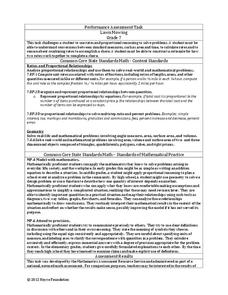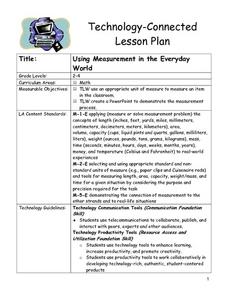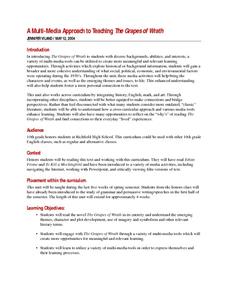Curated OER
"Math Curse" by Jon Scieszka
Young scholars explain everyday uses of numbers and relationships of numbers.
Curated OER
Math All Around Us!
Young scholars find math concepts in every day items. In this math concept lesson, students take ten photographs of things they find interesting. They analyze the photographs to find hidden math concepts such as counting, lines, angles,...
Curated OER
Transportation Math
Learners use mathematical operations to examine truck drivers and the math they use everyday. In this transportation math lesson, students read word problems that relate to transportation and the math needed to solve the word problems....
Curated OER
Problem Solving---A Part of Everyday Thinking
Students demonstrate knowledge of the six basic steps to problem solving. They demonstrate ability to apply these six basic steps to problem solving by guiding other students in the solution of a given problem or set of problems.
Curated OER
Real-World Reasonableness
Fifth graders apply math to real-world situations. In this mathematics lesson plan, 5th graders are read the book, "Math Curse," which discusses ways in which math is used each day. Students then write a sequel to the book in groups,...
Curated OER
Modeling Natural Disaster with Mathematical Functions
Ninth graders investigate the functional relationship of different environmental phenomena. In this math lesson, 9th graders create models of various natural disasters. They use logarithmic and exponential functions to interpret...
Curated OER
Equivalent Fractions Manipulatives
Students study fractions. In this equivalent fractions lesson, students utilize fraction strips to enhance their understanding of equivalent fractions. They watch a demonstration and then work independently with their own set of fraction...
Inside Mathematics
Marble Game
Pupils determine the theoretical probability of winning a game of marbles. Individuals compare the theoretical probability to experimental probability for the same game. They continue on to compare two different probability games.
Noyce Foundation
Lawn Mowing
This is how long we mow the lawn together. The assessment requires the class to work with combining ratios and proportional reasoning. Pupils determine the unit rate of mowers and calculate the time required to mow a lawn if they work...
Inside Mathematics
Swimming Pool
Swimming is more fun with quantities. The short assessment task encompasses finding the volume of a trapezoidal prism using an understanding of quantities. Individuals make a connection to the rate of which the pool is filled with a...
EngageNY
Choice of Unit
Explore using units with scientific notation to communicate numbers effectively. Individuals choose appropriate units to express numbers in a real-life situation. For this 13th lesson of 15, participants convert numbers in scientific...
Curated OER
What Contains Carbon?
Students explore elements by analyzing everyday objects and materials in class. In this carbon lesson, students define several vocabulary terms such as carbon dioxide, hydrocarbon, and carbonate. Students view a group of items,...
EduGAINs
Data Management
Using a carousel activity, class members gain an understanding of the idea of inferences by using pictures then connecting them to mathematics. Groups discuss their individual problems prior to sharing them with the entire class. The...
Curated OER
Math - "Where Am I?" Position in Space
A big part of understanding mathematical concepts is by mastering the vocabulary associated with those concepts. Students identify and explore positional/directional words as they relate to math. Students answer eleven fill-in-the-blank...
Curated OER
Everyday Is Agriculture Day
Students examine the role of the modern farmer through an interactive CD. Once they identify the role of farmers, they create typical farm schedules using math skills. In this lesson about Alaska agricultural products, students explore...
Curated OER
Using Measurement in the Everyday World
Students use an appropriate unit of measure to measure an item in the classroom. They create a PowerPoint to demonstrate the measurement process. Pupils are divided into pairs. Students use a concept map to discuss the terms for...
Curated OER
Everyday Objects with Shapes
Young scholars explore geometric shapes. In this geometry and language development lesson, students take a walk and look for shapes in the objects outdoors. Young scholars match each of four individual paper shapes they are carrying...
Curated OER
Math: Graphs and Their Symbols
Second graders examine different types of graphs and discover the meanings of the symbols used on them. After gathering data about themselves, their communities, and the world, they use that information to create graphs. Among the...
Curated OER
A Multi-Media Approach to Teaching The Grapes of Wrath
Integrate history, math, and art into a study of The Grapes of Wrath with a series of activities that ask learners to investigate the social, political, economic, and environmental factors at play during the 1930s. Designed to be used...
Missouri Department of Elementary
Be a Problem Solving Star
Encourage scholars to problem solve everyday frustrations using the STAR method. Using the acronym, learners remember to stop, think, act, and review. Participants begin with a math analogy in which they problem-solve to find the correct...
Baylor College
Need or Want?
Even as adults it can be hard to distinguish needs from wants. Using pictures of common, everyday items, children make a pocket chart separating the objects they need from those that they want. Discuss their choices, explaining that...
Curated OER
Attributes of Polygons: Stretchy Shapes
Fourth graders use dancing methodology in a polygon and shape activity. In this shape and dance instructional activity, 4th graders discuss shapes in dance, math, and everyday life. Students use dancing activities to recognize and...
Curated OER
Design Patterns
Students extend and create patterns. Through a variety of activities, they discover patterns as they exist in math and their everyday lives. Students create a necklace that represents a pattern.
Curated OER
Finding Equations
Students make equations from everyday data. They create a graph from the equations. Students predict and analyze the results. Students complete the second scenario on their own and turn in their handout.

























